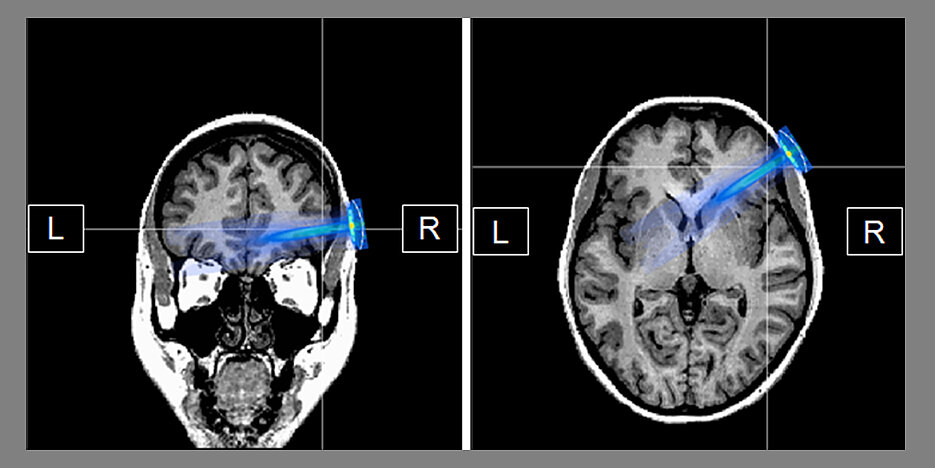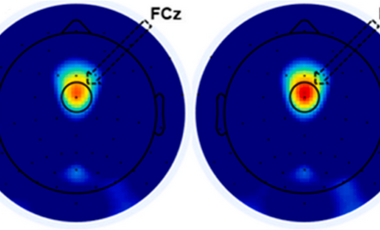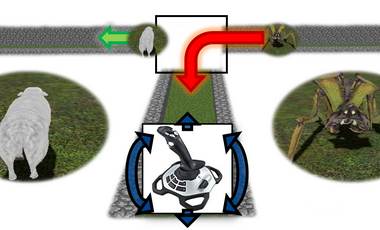Neuromodulation: Ultrasound Leads to Braver Behavior in Situations of Mental Conflict
02/01/2024Psychologists at the University of Würzburg have investigated the extent to which neuromodulation of the brain with ultrasound waves influences people's behavior. The results can also be used as a basis for therapeutic purposes.

When a new opportunity opens up for people, there are some who tend to take the pessimistic view: "It's no good anyway!". They may initially accept it, but in the long term they are constantly in a state of inner conflict. Such an attitude can be problematic, for example, if it leads to treatment discontinuation due to potentially overwhelming symptoms of inner conflict and withdrawal in cases of mental illness, so that therapeutic interventions are unable to develop their effectiveness. A new method that scientists from the Institute of Psychology at Julius-Maximilians-Universität Würzburg (JMU) are working on could provide a remedy with ultrasound waves.
Ultrasound can contribute to people's expectations becoming significantly more positive: This is the result of a study conducted by Prof. Dr. Johannes Hewig's research group. First authors are the psychologists Philipp Ziebell and PD Dr. Johannes Rodrigues. If a certain region of the brain is exposed to ultrasound waves for just two minutes, this can increase a 50 percent positive expectation to, for example, 60 or 70 percent, and in some cases even more. This is shown by psychological experiments with 152 people, which were carried out in cooperation with researchers from the University of Arizona, Prof. Dr. John Allen and Dr. Jay Sanguinetti. The results were recently published in the renowned journal "Brain Stimulation".
A nudge in a braver direction
"The whole procedure is relatively straightforward," explains Philipp Ziebell. During the treatment, a small ultrasound emitter is applied to a specific point on the head between the eye and ear for two minutes. This neuromodulation can give people a "nudge in a braver direction". Although the study only worked with a very low ultrasound setting for safety reasons, the predicted effects were seen in a remarkably large number of test subjects.
For over ten years, research teams have been trying to track down the possible positive effects of so-called low-intensity transcranial focused ultrasound (TUS). Prof. Dr. John Allen from the University of Arizona researched this as a Humboldt Fellow with a visiting professorship in Würzburg. As of now, the first studies have been published showing that ultrasound waves can indeed help bring depressed people out of their low mood.
Objective effects in a virtual maze
In these previous studies, the test subjects mainly used questionnaires to subjectively record the extent to which they felt better as a result of the TUS treatment. "We were now able to measure objective effects," reports Philipp Ziebell. All test subjects took part in three test units at intervals of one week: one for preparation, one with ultrasound and one with a placebo control condition (in a so-called randomized double-blind within-subjects study design). In the decisive test unit, ultrasound was first applied to the test subjects for two minutes, after which they were wired with 64 electrodes to the head. They then went to the computer for the test in a virtual maze, which was developed in extensive preliminary work by PD Dr. Johannes Rodrigues for the simultaneous measurement of electroencephalography (EEG) and behavior.
In this maze, the task of the study participants was to catch sheep and avoid spider monsters. A green light signaled them that a sheep was about to appear. They then had to move towards the sheep using a joystick. A red light warned them of the spider monster. Then they had to escape the maze as fast as possible. A yellow light signaled: Either a sheep or a spider monster will appear with a 50:50 chance. In this situation, it took courage to move quickly towards a possible sheep in order to catch it in time, knowing full well that a spider monster could also appear. Or they showed avoidance behavior and left the maze – at the possibility of missing a sheep.
Ultrasound can correct negative expectations
The result: In a substantial proportion of the test subjects, the ultrasound application led to significant reductions in an EEG parameter that reflects the experience of negative expectations as well as mental conflict, the mid-frontal theta frequency. These subjects were significantly braver in the 50:50 chances than in the placebo control condition, in which the ultrasound treatment was only pretended and in which there were no reductions in the mid-frontal theta frequency in the EEG. It can be deduced from this that ultrasound modulation could actually help to correct negative expectations.
Philipp Ziebell and his colleagues have now presented their findings at various national and international conferences. According to the psychologists, there is a great deal of interest and, given the novelty of the TUS topic, there is the prospect of manifold further research in the future. The next exciting step would be to individualize the ultrasound application, for example by taking individual anatomical characteristics into account.
An additional tool in the therapeutic toolbox
In addition to the ultrasound settings currently used, TUS offers numerous previously unavailable options for the targeted modulation of brain regions. Among other things, TUS opens up new ways of testing fundamental theories with active neuromodulation. In this way, basic research can provide new impetus for practical applications, for example in the treatment of mental illnesses. Another study from the Hewig working group conducted by Dr. André Forster recently provided further evidence in this regard by showing positive TUS effects on the suppression of learned helplessness, which serves as a central measure in the basic explanatory model of the development of depression.
"TUS could become an additional tool in the therapeutic toolbox and thus open up new therapeutic approaches," says Philipp Ziebell. Another advantage of the new method is that it can avoid unwanted side effects through the targeted use of low intensities. "We are operating within very safe parameters," emphasizes Philipp Ziebell. Until now, the intensity used in trials has tended to be especially low to be reliably on the safe side.
Original publication
Inhibition of midfrontal theta with transcranial ultrasound explains greater approach versus withdrawal behavior in humans. Philipp Ziebell, Johannes Rodrigues, André Forster, Joseph L. Sanguinetti, John J.B. Allen, Johannes Hewig. Brain Stimulation,
https://doi.org/10.1016/j.brs.2023.08.011
Contact
Philipp Ziebell, Department for Psychology I and Department for Psychology V, T: +49 931 31-84145, philipp.ziebell@uni-wuerzburg.de
Additional images








